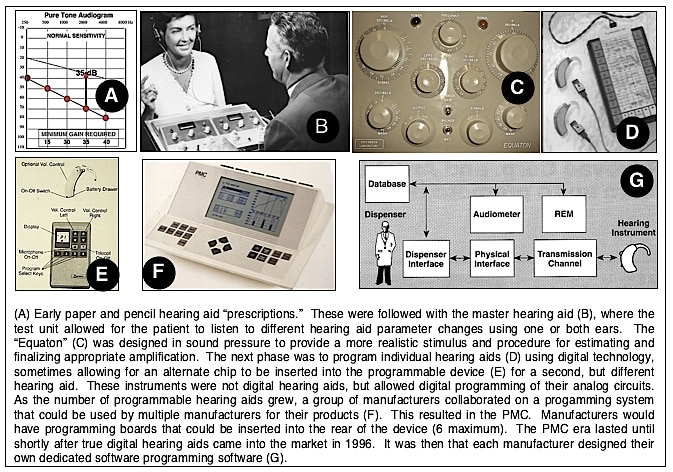 Hearing Aid Evolution: Part IV
Hearing Aid Evolution: Part IV
Technology and Techniques – A Hurried Ride Through History
An overview of approaches that have been used to select and fit hearing aids is the focus of this week’s post on this “ride through history” of the evolution of hearing aid technology and techniques. As with many other posts, detailed procedures are best left to textbooks on this subject.
This started as a two-part series, but soon changed because of my habit of expanding just about any topic I get involved with. As a result, this will end up as a five-part series. This is the fourth. Part one focused on factors that drive hearing aid development and then highlighted some of the major developments (primarily hardware) that shaped the changes to hearing aid design. Week two showed how the power supply (battery) is a major force in hearing aid design direction, along with miniaturization of two of the primary components of the hearing aid – the microphone and receiver/speaker. Last week (week three) looked at specific developments that helped shape the use of hearing aids. This week the focus is on hearing aid fitting directions.
Hearing Aid Fitting Directions
Hearing aid selection and fitting procedures have undergone numerous changes, and modifications are expected to continue. The path has been strewn with many variations of the highlighted approaches that follow. But, one soon realizes, the wheel is often reinvented.
- Pencil and Paper Selection (A) – Early hearing aid selection approaches mostly consisted of paper and pencil formulae. The pure-tone audiogram was recorded, and some form of calculation was applied to the threshold measurements to determine essentially the gain per frequency and, on occasion, the output SPL. Most of these were modifications of “fitting the audiogram.” This description found disfavor among the professional hearing aid fitting community because fitting gain to the audiogram loss did not result in satisfactory fittings. As a result, other “enlightened” descriptions followed, but as history shows, they all started from the audiogram and then adjusted the gains according to some subjective formula. The irony is that essentially all current hearing aid fitting approaches continue to be based on the audiogram, even though “fitting the audiogram” is considered ill advised.
- Master Hearing Aids (B) – These consisted of dedicated electronics that simulated different hearing aid response, gain, output, compression, etc. parameters. In essence, these served as in office “hearing aids” that a consumer could listen to and make decisions as to what settings allowed for the most satisfactory listening. This would at least giv patients an idea what amplification sounded like before they made the decision to purchase hearing aids. The fitted hearing aid would emulate these parameter settings. A primary criticism was that hearing aid selection was made with audiometric earphones, which had much better frequency responses and electronics than actual hearing aids that used transducers with more restricted frequency response. This was corrected by some companies that used actual hearing aids and wired these to the master hearing aid consol. During this period (primarily the late 1960s to mid-1970s), most major hearing aid companies provided master hearing aids to their dealer network.
- Otometry (C) – This was a sound pressure approach to hearing aid selection and validation developed by John Victoreen. Although not acknowledged by most who have developed hearing aid fitting approaches, Otometry encapsulated the fundamentals of contemporary hearing aid selection formulae/approaches. This procedure and equipment used a damped wave signal, made threshold measurements in 2-dB increments, recorded all levels in SPL, and operated on the basis of equal loudness listening for the different frequencies. Otometry determined that the most satisfactory amplification occurred when the hearing aid wearer responded to equal loudness at 72 dB SPL across frequencies (with some minor adjustments at 250 and 500 Hz). This writer uses the Equaton (or as Dr. Darrell Rose referred to it as the “bonk box”) to find out if a hearing aid fitting approximates the Otometry goal.
- Programmable Hearing Aids – Most contemporary hearing aids are computer programmable using either a recognized general fitting formula or a proprietary fitting approach designed by the hearing aid manufacturer (based on pure-tone thresholds). Early programmable hearing aids were dedicated programs able to set a limited number of hearing aid parameters for a specific instrument in the manufacturer’s line (D). These programming devices (primarily hand-held) subsequently developed to allow more extensive programming, but still just for specific instruments (E). This was followed with a programming device that could be used to program hearing aids from multiple manufacturers, provided they had a programming card that could be inserted into the back of the Programmable Multi-Channel (PMC) device (F). However, the need for manufacturers to maintain and control multiple programmable hearing aids within their line has resulted in each manufacturer having computer-based programming that is unique to and designated for their products (G). This is the current status.
Next week’s post will conclude this series with a discussion of implantable hearing devices and approaches used to couple the hearing aid to the ear.








